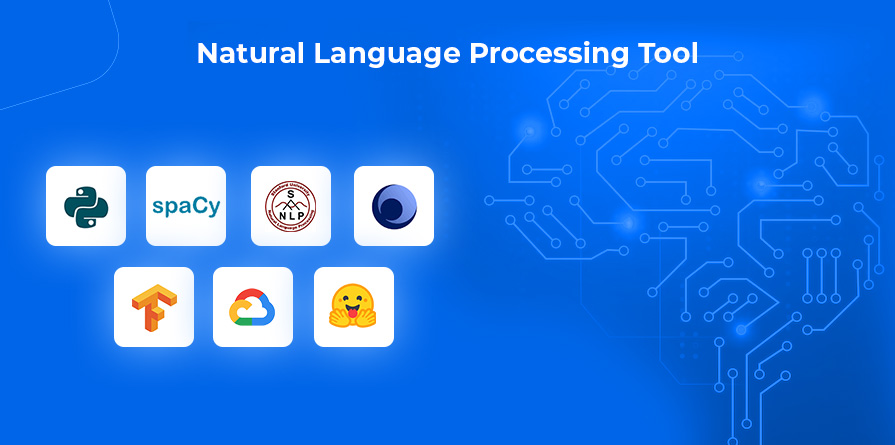How Natural Language Processing Makes Mobile Apps Smarter?
Natural Language Processing (NLP) is a branch of artificial intelligence that focuses on the interaction between computers and human language. It involves the development of algorithms and techniques that enable computers to understand, interpret, and generate natural language in a way that mimics human communication. NLP applications have gained significant traction in recent years, transforming various industries and enhancing user experiences. From sentiment analysis and language translation to speech recognition and text classification, NLP empowers computers to comprehend and process human language, making it a vital technology in our increasingly interconnected and language-driven world.
What Is Natural Language Processing?
Natural Language Processing (NLP) is a branch of artificial intelligence that focuses on the interaction between computers and human language. It involves the development of algorithms and techniques that enable machines to understand, interpret, and generate natural language in a way that is meaningful and useful. NLP encompasses various tasks such as speech recognition, language understanding, sentiment analysis, language translation, and more. By leveraging computational power and linguistic knowledge, NLP enables machines to process, analyze, and derive insights from human language, facilitating communication and interaction between humans and computers.
How Does Natural Language Processing Work?
Natural Language Processing (NLP) works through a series of computational algorithms and techniques that enable computers to understand, interpret, and generate human language. The process involves several key steps:
- Tokenization : The text is divided into smaller units called tokens, such as words or characters, to provide a structured representation.
- Morphological Analysis : This step analyzes the structure and formation of words, considering features like inflexions, prefixes, and suffixes to understand the grammatical and semantic meaning.
- Parsing : Parsing involves analyzing the syntactic structure of sentences to determine the relationships between words and their roles in the sentence, creating a parse tree or syntactic structure.
- Semantic Analysis : This step focuses on understanding the meaning of words and sentences. It involves assigning semantic roles, identifying named entities, and resolving pronouns and references.
- Disambiguation : Ambiguity in language, such as homonyms or polysemy, is resolved to determine the correct meaning based on the context.
- Sentiment Analysis : Sentiment analysis identifies the emotional tone or sentiment expressed in text, helping to understand whether it is positive, negative, or neutral.
- Machine Learning and Statistical Models : NLP often utilizes machine learning algorithms and statistical models to process and analyze large amounts of text data. These models can be trained on labeled datasets to improve accuracy and performance in tasks like language understanding, translation, and sentiment analysis.
- Natural Language Generation : NLP also enables machines to generate human-like language. This involves transforming structured data or instructions into coherent and understandable sentences or texts.
- Integration with Applications : NLP is integrated into various applications and systems to provide language-related functionalities such as voice assistants, chatbots, automatic summarization, information extraction, and machine translation.
By combining linguistic knowledge, machine learning, and statistical analysis, NLP enables computers to understand and work with human language, leading to advancements in areas such as information retrieval, text mining, language translation, and intelligent human-computer interaction.
Types of NLP Applications
- Sentiment Analysis : Sentiment analysis, also known as opinion mining, involves analyzing text data to determine the sentiment or emotion expressed. This application is widely used in social media monitoring, customer feedback analysis, brand reputation management, and market research.
- Language Translation : Language translation is a fundamental NLP application that involves automatically translating text or speech from one language to another. This application finds immense utility in global communication, cross-border business transactions, and multilingual content generation.
- Named Entity Recognition (NER) : NER is the process of identifying and classifying named entities, such as names of people, organizations, locations, dates, and other specific information, within text data. NER is used in various domains, including information extraction, question-answering systems, and knowledge graph construction.
- Speech Recognition : Speech recognition involves converting spoken language into written text. This application is used in voice assistants, transcription services, voice-controlled systems, and applications that require hands-free operation.
- Text Classification : Text classification is the task of categorizing text data into predefined classes or categories. This application is used in spam filtering, sentiment analysis, topic classification, document classification, and content moderation.
These five types of NLP applications represent a diverse range of use cases, showcasing the broad impact of NLP across industries such as social media, translation, information extraction, voice-enabled systems, and data classification.
Uses Of NLP Technology in Mobile Apps Smarter
The use of Natural Language Processing (NLP) technology in mobile apps has made them smarter and more intuitive, providing a range of benefits to users. Here are some key uses of NLP technology in mobile apps:
- Voice Commands and Speech Recognition : NLP enables voice-controlled interactions, allowing users to perform tasks, make requests, and navigate through the app using voice commands. Speech recognition technology converts spoken language into text, enabling the hands-free operation of the app.
- Virtual Assistants and Chatbots : Mobile apps can incorporate virtual assistants or chatbots powered by NLP to provide personalized assistance, answer user queries, and perform tasks. These conversational interfaces understand natural language and can engage in interactive conversations, enhancing user engagement and satisfaction.
- Language Translation and Localization : NLP enables real-time language translation within mobile apps, allowing users to communicate and understand content in different languages. Mobile applications provide language translation features for text, voice, or even image-based translation. NLP also facilitates app localization, adapting the app’s content and interface to specific languages and cultural nuances.
- Sentiment Analysis and Feedback Analysis : NLP techniques can be employed to analyze user feedback, reviews, and social media posts to understand the sentiment or emotion behind them. Mobile apps can utilize sentiment analysis to gather insights, improve products or services, and enhance user experiences based on user feedback.
- Natural Language Understanding and Search : NLP enables mobile apps to understand user queries and provide relevant search results or recommendations. By comprehending the intent, context, and meaning behind user input, apps can deliver more accurate and personalized search results, improving the overall user experience.
- Text Analysis and Summarization : NLP allows mobile apps to analyze and process text data, extracting valuable insights and summarizing lengthy content. Text analysis techniques such as named entity recognition, keyword extraction, and topic modelling can be used to provide relevant information and summaries to users.
- Contextual Understanding and Personalization : NLP enables mobile apps to understand user preferences, behavior, and context to deliver personalized experiences. By analyzing user interactions, app usage patterns, and historical data, NLP-powered apps can provide tailored recommendations, content, and suggestions to individual users.
- Speech-to-Text and Text-to-Speech : NLP enables mobile apps to convert speech into text (speech-to-text) and text into synthesized speech (text-to-speech). This functionality can be used for various purposes such as transcription services, voice messaging, accessibility features, and voice-guided navigation.
- Intelligent Data Input and Autocorrect : NLP technology can assist in intelligent data input by suggesting relevant words, auto correcting misspelled words, and predicting the next word in a sentence. This improves typing efficiency, reduces errors, and enhances the overall user typing experience in mobile apps.
By leveraging NLP technology, mobile apps become smarter, more user-friendly, and capable of understanding and responding to user needs more effectively. These applications enhance the overall user experience, improve personalization, and make mobile apps an indispensable tool in various domains, from productivity and communication to entertainment and e-commerce.
Most Popular Natural Language Processing Tool

There are several popular natural language processing (NLP) tools available, each with its own strengths and areas of focus. Here are some of the most widely used NLP tools:
- NLTK (Natural Language Toolkit) : NLTK is a popular open-source Python library for NLP. It provides a wide range of functionalities, including tokenization, stemming, tagging, parsing, and classification. NLTK also offers a comprehensive collection of text corpora and lexical resources for NLP research and experimentation.
- SpaCy : SpaCy is a robust and efficient NLP library for Python. It offers fast and accurate tokenization, part-of-speech tagging, named entity recognition, dependency parsing, and other common NLP tasks. SpaCy is known for its speed, scalability, and ease of use, making it a popular choice for production-grade NLP applications.
- Stanford CoreNLP : Stanford CoreNLP is a suite of NLP tools developed by Stanford University. It provides a wide range of functionalities, including tokenization, part-of-speech tagging, named entity recognition, sentiment analysis, and coreference resolution. CoreNLP supports multiple languages and provides pre-trained models for various NLP tasks.
- SpeechGensim : Gensim is a Python library that specializes in topic modeling and document similarity analysis. It provides efficient implementations of popular algorithms such as Latent Semantic Analysis (LSA) and Latent Dirichlet Allocation (LDA). Gensim is widely used for extracting topics and discovering hidden patterns in large text collections.
- TensorFlow (with TensorFlow Natural Language Processing library) : TensorFlow is a popular machine learning framework that includes a dedicated library for NLP called TensorFlow NLP. It provides a wide range of pre-built models and tools for tasks like text classification, sequence labeling, sentiment analysis, and machine translation.
- BERT (Bidirectional Encoder Representations from Transformers) : BERT is a pre-trained deep learning model for NLP developed by Google. It has achieved state-of-the-art results on various NLP benchmarks and tasks. BERT provides contextualized word embeddings, allowing models to understand the meaning of words in the context of the entire sentence.
- Hugging Face Transformers : Hugging Face Transformers is a powerful library built on top of PyTorch and TensorFlow for working with transformer-based models in NLP. It provides easy access to a wide range of pre-trained models, including BERT, GPT, and RoBERTa. The library supports tasks like text classification, named entity recognition, text generation, and more.
These are just a few examples of popular NLP tools and libraries. The choice of tool depends on the specific requirements of your project, the complexity of the NLP tasks involved, and the programming language you prefer to work with.
Conclusion
Natural Language Processing (NLP) has become a vital technology in the realm of mobile app development. Its applications, such as sentiment analysis, language translation, speech recognition, and text classification, have significantly enhanced the capabilities and intelligence of mobile apps. By integrating NLP into mobile apps, businesses can deliver more personalized and engaging user experiences, enable voice-controlled interactions, and provide real-time language translation. As the demand for intelligent mobile apps continues to grow, partnering with a mobile app development company that leverages NLP technology can be a strategic move to stay ahead in the competitive market. NLP empowers mobile app developers to create smarter, more intuitive, and language-savvy applications that cater to the evolving needs and preferences of users.
